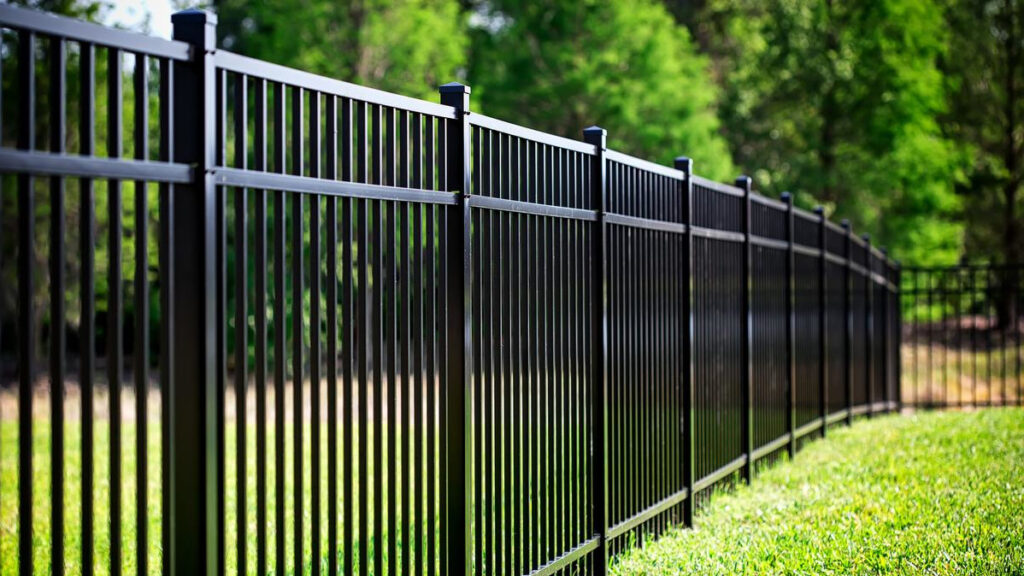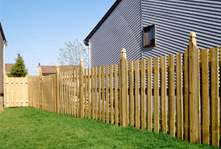A Comprehensive Overview to Fencing Install: What You Need to Know About Secure Fencing Provider
When it comes to mounting a fencing, you have actually got a lot to consider. You'll require to evaluate your residential or commercial property and determine if you desire to deal with the setup on your own or hire a professional.
Comprehending Various Types of Fence Materials
When you're choosing a fencing, recognizing the different kinds of fence products is essential. Each product uses one-of-a-kind advantages and disadvantages, affecting your decision. Timber provides a classic look and can be tailored, yet it calls for normal upkeep and might rot in time. Plastic is low-maintenance and resilient, standing up to fading and insects, but it can be pricier upfront. Chain-link fencing is economical and functional for enclosing large areas, though it does not have privacy and aesthetic charm. Metal fencing, like wrought iron or light weight aluminum, provides stamina and elegance but might require corrosion defense. Compound products blend the most effective of timber and plastic, using toughness with an all-natural appearance. Consider your budget, preferred looks, and upkeep preferences when evaluating these alternatives. Inevitably, picking the ideal material will certainly help you produce a fence that fulfills your requirements and improves your property's worth.
Evaluating Your Building and Fence Requirements
Before you begin your fence setup, it's necessary to examine your residential or commercial property boundaries and the function of your fencing. Comprehending regional policies and authorizations will certainly likewise help you avoid any type of legal problems down the line. By taking into consideration these aspects, you'll ensure your fence fulfills both your requirements and area criteria.
Building Limits and Lines
Understanding your residential property limits is important for a successful fence installation, as it not just helps you figure out where your fencing will go yet additionally ensures you're valuing your neighbors' area. Start by assessing your property action or survey, which commonly outlines the precise borders. You may also wish to talk to a professional surveyor if you're not sure.
Bear in mind, neighborhood zoning regulations may dictate fencing positioning and elevation, so inspect those guidelines also. Taking these actions guarantees your fencing is properly placed and compliant, making the entire process smoother for you.
Purpose of Fence
Third, fence can specify your residential or commercial property boundaries, making it clear where your space finishes and your next-door neighbor's begins. A well-placed fence can aid manage noise from neighboring roadways or neighbors and even keep family pets and youngsters secure. By evaluating your specific demands, you can pick the best kind of fencing to achieve these benefits efficiently.

Local Regulations and Permits
Just how can you ensure your fence installation abides by local laws? Start by getting in touch with your regional zoning office or metropolitan internet site. Fencing in Auckland. They commonly have guidelines concerning fence elevation, materials, and placement. You'll additionally intend to discover out if you require a license before beginning your job. Some locations require permits for any brand-new fencing, while others might only require them for taller structures.
Furthermore, consider residential or commercial property lines and any kind of easements on your land. Marking your limits can stop conflicts with next-door neighbors or prospective legal concerns. By comprehending these guidelines upfront, you can stay clear of expensive mistakes and establish your fence is built to last, improving both your property's value and your assurance.
Local Laws and Permits for Fence
Prior to you begin your fencing job, it's crucial to examine regional policies and acquire any necessary permits. Each city or region has its own regulations relating to fencing elevation, materials, and positioning. These guidelines ensure that your fencing follows security requirements and area aesthetics.
You might require to submit a fencing strategy, detailing dimensions and products. Some locations might even call for a study to confirm residential property borders.
Neglecting to follow these policies can cause fines or required removal of your fence, squandering both money and time. So, put in the time to research study and safeguard the proper licenses for a smooth installment procedure. This action is crucial in making certain your task aligns with local legislations and area criteria.
Selecting Between DIY Installation and Professional Solutions
Are you taking into consideration whether to deal with the fence installment on your own or hire a specialist? If you're useful and have experience with comparable tasks, Do it yourself may save you cash.
Installing a fencing takes time, and if you're juggling an active timetable, working with an expert can ensure it obtains done successfully. If your backyard has tough surface or particular layout requirements, experts bring proficiency that can make a distinction.
Finally, element in local imp source laws. A specialist knows the licenses and codes needed, assisting you prevent possible fines. Ultimately, weigh your skills, time, intricacy, and regulations to make the very best option for your fencing job.
Step-by-Step Overview to Fence Setup
As soon as you've made a decision to progress with your fencing installation, complying with an organized detailed approach will guarantee a smooth process. Beginning by marking the fence line with risks and string to visualize the layout. Next, check regional laws to verify conformity with elevation and residential property lines.
Dig blog post openings at least 2 feet deep, spaced according to your fencing type-- generally 6 to 8 feet apart. Insert the messages into the openings and load them with concrete for security. When the posts are established, attach the horizontal rails or panels, making certain they're level.
Check for any type of loosened links and make required adjustments. Your fence should currently be all set to boost your building and provide the privacy or safety and security you require!
Upkeep Tips for Long Life of Your Fence
To keep your fencing looking wonderful and long lasting longer, routine upkeep is crucial. You need to set up a cleaning routine, inspect for any damage, and apply protective coverings as needed. By staying aggressive with these tasks, you'll assure your fencing stays strong and appealing for years to come.
Routine Cleansing Arrange
While it may be very easy to neglect, establishing a routine cleaning timetable is crucial for keeping the durability of your fence. Start by washing your fence with water a minimum of when every period to get rid of dust and debris. For wooden fencings, make use of a mild soap service and a soft brush to scrub away any type of mold and mildew or mold. Don't fail to remember to look for any type of corrosion on metal fences; a cord brush can help eliminate it, complied with by a layer of rust-resistant paint. If you reside in an area with heavy plant pollen or dirt, you may wish to enhance your cleansing frequency. Maintaining your fence tidy not just enhances its look however additionally prolongs its life, saving you money in the long run.
Examine for Damages
Frequently inspecting your fence for damage is important if you wish to maintain its stability and durability. Begin by strolling around your fencing to look for visible signs of wear, such as fractures, my site loosened boards, or rust. Pay unique attention to the base and posts, where wetness can create substantial problems. If you see any damages, keep in mind and establish the urgency of fixings. Dealing with little issues quickly can prevent them from intensifying right into bigger, much more expensive issues. Look for any kind of signs of bugs, like termites or woodpeckers, that can compromise your fencing's framework. Ultimately, validate that your fencing continues to be stable by inspecting for any type of leaning or drooping sections. Routine assessments will certainly maintain your fencing looking terrific and working properly for several years to come.
Apply Safety Coatings
After inspecting your fencing for damage, applying protective coverings is an essential action in ensuring its long life. Depending on the material, you'll desire to select the best type of coating. For wood fences, a high-quality sealant or timber discolor can avoid dampness absorption and discourage bugs. If your fencing is plastic or metal, take into consideration a UV-protective spray or paint to stop fading and rust.
See to it to clean up the surface area thoroughly prior to application, as dirt and crud can weaken the layer's efficiency. Apply the layer in dry weather condition for far better adhesion, and do not fail to remember to comply with the supplier's directions for the ideal results. Consistently reapply every few years to maintain your fence looking excellent and standing strong versus the elements.
Price Factors To Consider and Budgeting for Your Fencing Project
When intending your fencing project, comprehending cost considerations is necessary to remaining within budget plan. Beginning by determining the sort of material you desire, as prices can differ substantially in between timber, plastic, and steel. Do not neglect to factor in labor costs-- employing professionals may conserve you time however can boost your general costs.
Following, determine your home to calculate the linear footage needed, as this straight influences product prices. Additionally, think about any kind of licenses you might need, which can contribute to your budget.

Lastly, it's a great idea to establish apart a contingency fund for unanticipated expenses. By preparing very carefully and considering these aspects, you can create a sensible budget plan that fulfills your fence requires without breaking the bank.
Often Asked Concerns
The length of time Does the Average Fencing Setup Take?
The average fence installation typically takes one to 3 days, depending upon the fencing type and size of your backyard. You'll require to take into consideration any kind of delays as a result of weather or permit requirements as well.
What Should I Do if My Fencing Is Harmed?
If your fencing is damaged, first evaluate the level of the damages. Repair minor problems on your own, however for significant issues, think about getting in touch with an expert. Do not wait as well long; it'll assist prevent further complications.
Can I Mount a Fencing on a Slope?
Yes, you can install a fencing on an incline. You'll need to change your installation approach, either by tipping the panels down or utilizing a racked design to ensure stability and correct positioning with the terrain.
What Are the most effective Practices for Fence Paint?
To paint your fencing properly, begin with correct cleaning and sanding. Use high-grade paint and apply in even strokes. Do not forget to pick the ideal weather for paint, guaranteeing it's completely dry and mild.
Just how Commonly Should I Check My Fencing?
You need to inspect your their explanation fence at the very least twice a year, concentrating on indicators of damage, rot, or rust. Routine checks help you catch issues early, guaranteeing your fence stays tough and aesthetically appealing much longer.